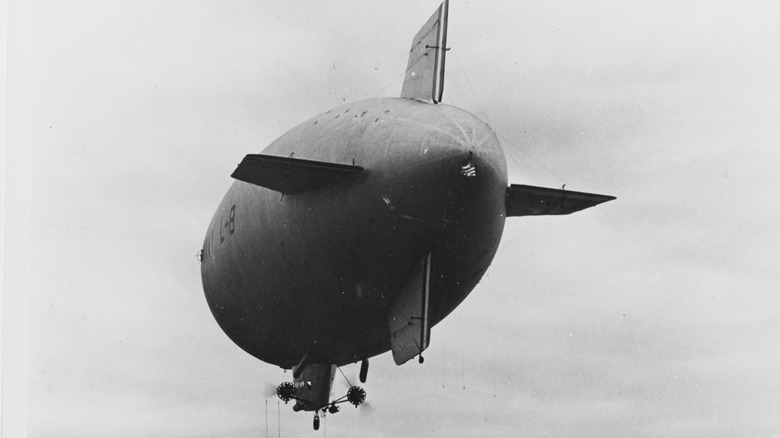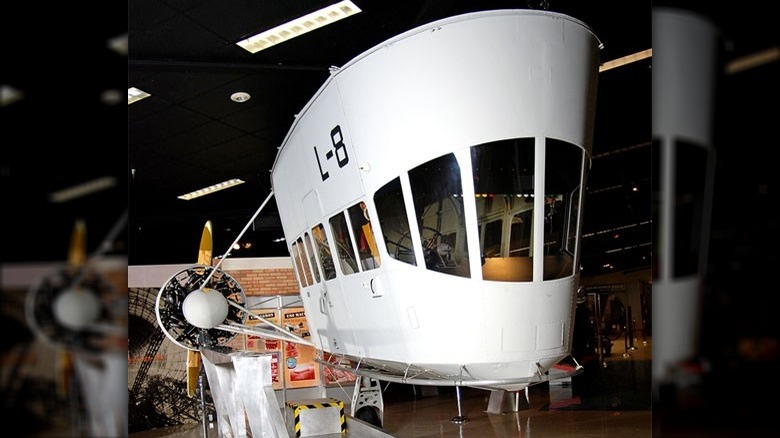Why The Ghost Blimp Of 1942 Still Remains A Mystery
In 1942, the abandoned U.S. Navy blimp, L-8, drifted into Daly City, Calif., where it crashed to a halt. The ensuing investigation found no crew members on board. Aside from the damage done by the accidental crash, the nonrigid dirigible was deemed in perfect condition (via Smithsonian Magazine). Although many witnesses saw the blimp's journey, nobody saw what happened to the crew and their parachutes were found still on board.
Just five hours earlier, around 5:30 a.m., the craft took off from Treasure Island, located near San Francisco, with two crewmen on board (via SFGate). At around 7:38 a.m., one of the crewmen radioed to report a strange oil spill not far from Golden Gate Bridge. Witnesses spotted L-8 dropping flares to mark the oil spill before it sailed away.
When the ghostly dirigible was found, it was missing an anti-submarine depth charge and two life jackets. Witnesses later confirmed that the drifting balloon collided with a hill and lost one of its explosives by accident. Neither of the pilots — LTJG Ernest DeWitt Cody and ENS Charles Ellis Adams (per U.S. Naval Institute (USNI)) — were ever found. To this day, the mystery of L-8 has never fully been solved.
A world at war
One reason for the enduring paranoia about the mysterious ghost blimp is that the crew disappeared during the height of World War II. The oil spill the men spotted on the water was worthy of investigation because it can sometimes indicate the presence of a submarine (via Smithsonian Magazine).
One popular theory is that the men really found a sub and were taken prisoner by the Japanese Navy (via SF Gate). Some people have even speculated that the airmen were Japanese spies and might have defected, although there is no evidence of any sort of espionage on the parts of Cody and Adams. Another alternative theory is that somebody stowed away on board the vessel before they got on, surprising the crew and throwing them overboard. Like the previous theory, there is no evidence to support this.
Japanese subs were indeed lurking in the area around the time the blimp was patrolling. However, it seems unlikely that a Japanese submarine crew could have climbed from the water onto the blimp to capture them, especially in broad daylight in a bustling shipping lane. A cargo ship in the area, the Albert Gallatin, also followed the blimp's movements after it dropped its flares and probably would have seen any suspicious activity at sea.
The official story and fringe theories
The official theory was that the crewmen fell out or fled L-8 (via Smithsonian Magazine). One theory is that Cody and/or Adams may have attempted something risky, such as fixing part of the ship and accidentally fell into the ocean. Some have suggested that one man fell and the other jumped to rescue him. But if that's the case, the second crewman didn't use a parachute or life raft and didn't radio for help (via San Francisco Chronicle). USNI explains that the two men would have fallen from a height of approximately 300 feet, and their bodies would have sunk right away, unable to surface.
Another theory suggests that the crew was testing a secret military radar when things went seriously wrong. Microwave radiation from the dodgy equipment disoriented the pilots, causing them to fall from the craft (via SF Gate). However, this theory also can't be substantiated.
Nevertheless, what exactly happened to L-8's crew remains an enduring mystery. One of the last tangible pieces of L-8, her control car, can be found at the National Naval Aviation Museum in Pensacola, Fla.


